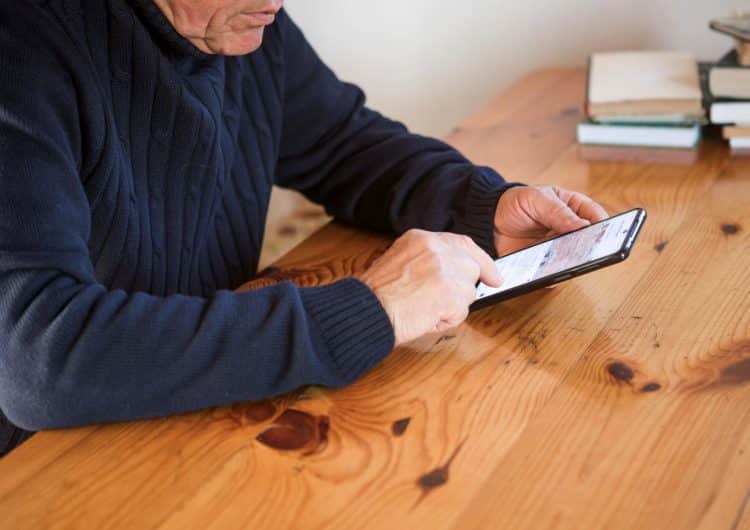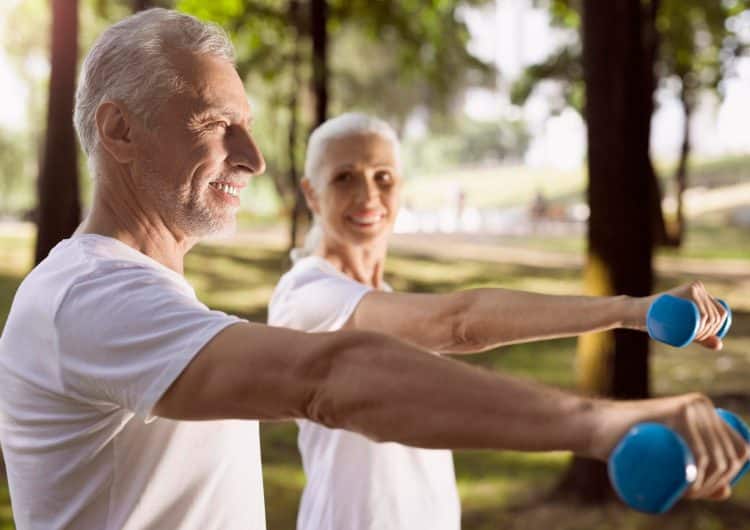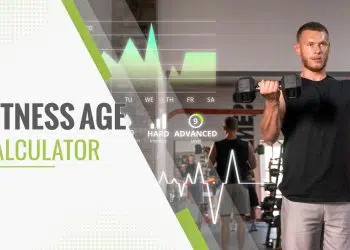Elderly Mobility Scale Calculator
Results:
calculated
Elderly Mobility Scale (EMS)
Interpretation: calculated
Mobility means different things to different people. For exercisers, mobility usually refers to the ability to move a joint through its full range of motion. This type of mobility is closely related to flexibility and is also influenced by joint health.
However, mobility can also refer to your ability to move around, i.e., going from sitting to standing and walking. Using this second definition, older people often experience decreased functional mobility, making it increasingly difficult to live independently. Poor mobility is also linked to an increased risk of suffering a fall.
The Elderly Movement Scale assess locomotion, balance, and changes of position in older people to determine whether they need help to live independently (1).
What Is the Elderly Mobility Scale Calculator?
The Elderly Mobility Score (EMS) was devised in 1994. It’s a series of seven tests that assess mobility and balance in older people. It replicates several of the activities of daily living, and the final score indicates whether the subject would benefit from additional assistance, such as a walking frame or live-in care.
A low EMS score also suggests that the subject has an increased risk of suffering a fall. Falls can be very dangerous and even fatal for older people. That’s because many seniors have weak, fracture-prone bones (due to osteopenia and osteoporosis) and don’t have the strength to get up from the floor after falling.
The EMS is used in hospitals to assess the readiness of a senior to be discharged. In some cases, the subject may need hands-on assistance to live at home. The EMS can also measure improvements in strength and balance, e.g., after physiotherapy or occupational therapy.
Level Up Your Fitness: Join our 💪 strong community in Fitness Volt Newsletter. Get daily inspiration, expert-backed workouts, nutrition tips, the latest in strength sports, and the support you need to reach your goals. Subscribe for free!
The Elderly Mobility Scale can be used alone but, in a medical setting, is usually administered in conjunction with other tests, including memory and reasoning.
How Does the Elderly Mobility Scale Calculator Work?
The Elderly Mobility Scale calculator comprises seven individual assessments. Those assessments are:
- Going from a lying to a sitting position.
- Moving from a sitting to a lying position.
- Going from sitting to standing.
- Standing with or without support.
- Gait issues during walking.
- Timed walk for 6 meters.
- Reach overhead while standing in place.
Points are awarded or deducted based on an individual’s performance. For example, going from lying to sitting unaided scores two points, whereas the same maneuver, while needing the assistance of two or more people, scores zero.
| EMS Test | Criteria/scoring |
| Lying to Sitting |
|
| Sitting to Lying |
|
| Sitting to Standing |
|
| Standing |
|
| Gait |
|
| Timed Walk (6 meters) |
|
| Functional Overhead Reach |
|
The highest obtainable score is 20, but anyone scoring less needs hands-on supervision to prevent falls. To save you from doing lots of math, our EMS calculator crunches all the numbers for you. All you need to do is input the score for each test from the dropdown menus.
How to Use the Elderly Mobility Scale Calculator
To perform the Elderly Mobility Scale, you will need the following:
- A metric ruler
- A metric tape measure
- A stopwatch
- A bed
- A chair
- The subject’s usual walking aids
- At least 6-meters of clear space
- 2 assistants
- Notepad and pen/EMS calculator
Armed with this equipment, complete the following assessments:
- With the subject lying flat on a bed, ask them to sit up. Assist if necessary. Observe their performance and enter the result in the EMS calculator.
- Leading on from test #1, ask the subject to lie back down on the bed. Assist if necessary. Observe their performance and enter the result in the EMS calculator.
- Next, with the subject sitting in a chair, ask them to stand up. Assist if necessary. Observe their performance and enter the result in the EMS calculator.
- For the next test, ask the subject to stand up and extend their arms out in front of them. Assist if necessary. Observe their performance and enter the result in the EMS calculator.
- Next, ask the subject to walk around the room. Assist if necessary. Observe their performance and enter the result in the EMS calculator.
- For this assessment, ask the subject to walk 6 meters as quickly as possible. Time them and enter the result in the EMS calculator.
- Finally, ask your subject to reach up above their head. Measure how high they can reach above shoulder level and enter the results in the EMS calculator.
- Hit “calculate” and read off the score in the box below.
Interpreting your Results
After hitting “calculate,” you’ll receive the subject’s score out of 20. Each score comes with recommendations regarding the amount of assistance or supervision the subject requires.
| EMS Score | Result Interpretation |
| 14 – 20 | The subject can perform the basic activities of daily living. They may require some help but are generally safe alone at home. |
| 10 – 13 | The subject has scored borderline independence in the basic activities of daily living. However, they still require some assistance with mobility-related activities. |
| 0 – 9 | The subject requires help with the basic activities of daily living and needs long-term, hands-on care. |
How to Improve your EMS Score
In some cases, the Elderly Mobility Score cannot be improved. For example, if the subject has severe osteoarthritis or impaired muscle control due to a neurological disorder, e.g., neuropathy or a stroke.
However, some subjects will be able to improve their EMS score, which could enhance their quality of life and make the tasks of everyday living easier to perform.
Effective interventions include:
Weight loss
Moving around requires a lot of muscle power, and older people tend to have less muscle compared to when they were younger. Losing weight means less resistance for the muscles to overcome, making tasks like standing and walking much easier.
Weight loss requires a calorie deficit, meaning the subject must consume fewer calories than their TDEE. However, as significant amounts of exercise are not really an option, a reduced-calorie diet is arguably the best option for weight loss in seniors.
Strength training
The human body operates on a system of “use it or lose it.” The less you move around, the weaker you get, so you move around even less. It’s a vicious circle!
Level Up Your Fitness: Join our 💪 strong community in Fitness Volt Newsletter. Get daily inspiration, expert-backed workouts, nutrition tips, the latest in strength sports, and the support you need to reach your goals. Subscribe for free!
Break this cycle by doing some strength training. This doesn’t mean heading to the gym and pumping iron. Instead, subjects should do seated and lying exercises with resistance bands and try some isometrics. They should also practice the tests of the EMS, as they’ll provide an excellent workout for deconditioned elderly people.
Contrary to popular opinion, you can gain and regain strength at any age – even during your senior years (2).
Hobbies and games
The less you do, the less you tend to want to do, and it’s easy to become stuck in a rut of inactivity and sedentarism. Hobbies such as gardening, painting, and card and board games can help fill the time and provide mental and physical stimulation. They’re like training in disguise!
Encourage the subject to engage in hobbies and games to enhance mental and physical performance and complement their exercise and weight loss efforts. Anything will be more beneficial than watching hour after hour of TV.
EMS FAQ
Do you have a question about the Elderly Mobility Scale Calculator? We’ve got the answers!
1. What age group is the Elderly Mobility Score calculator for?
The Elderly Mobility Scale (EMS) calculator is designed for geriatrics, which is the medical term for anyone over the age of 65. However, some people may become less mobile at a younger age, while others may be more mobile at an older age.
The calculator does not consider chronological age, and all results are based solely on performance. As such, anyone can use this calculator to assess their functional mobility for walking and living independently.
2. What would be a good weight loss diet for a senior?
Any diet or eating plan that reduces calorie intake to below the level of TDEE will result in weight loss in the elderly. However, because the subject will probably be quite sedentary, the calorie deficit may need to be a little larger than for an active person to achieve weight loss.
Regardless of the diet chosen, meals should be built around lean proteins, vegetables, whole grains, natural fats, and other healthy foods. The vitamins, minerals, and fiber will do wonders for health, energy, and well-being.
Seniors should also endeavor to drink plenty of water, which is critical for vestibular health and balance.
Read more about creating a healthy long-term diet in this article.
3. How often should the Elderly Mobility Scale Assessment be performed?
The EMS can be performed weekly. However, improvements will probably take longer to manifest, i.e., monthly. That said, just doing the EMS assessments can be something of a workout, and there is no reason not to use these assessments as a form of training.
4. What are some good strength exercises for seniors?
Most standard strength training exercises can be modified for seniors. For example, squats become standing and then sitting in a chair for reps, and the bench press becomes chest press with bands. Because strength is low, these exercises will not require a lot of resistance to be effective. In some cases, the weight of the limb will be sufficient.
Other good exercises include:
- Seated leg extensions (in a chair)
- Lying leg curls (on a bed)
- Squats to a chair
- Overhead press (raising arms above the head)
- Resistance band rows
- Push-ups against a wall
- Isometric biceps curls
5. What are the implications of a low EMS score?
A low EMS score could mean that the subject lacks the mobility, balance, and strength to live alone. For example, they may have trouble walking, be unable to get out of bed or up from a chair, or have an increased risk of suffering a fall.
In some cases, patients with a low EMS score only need a small amount of assistance, e.g., a walking frame or strategically placed handles in their home for balance and support. However, others may need live-in, full-time help or residential care.
While aging happens to everyone, exercising for as many years as possible and eating healthily can significantly reduce your rate of aging and the degree of physical decline you’re likely to experience.
Wrapping Up
The Elderly Mobility Scale was designed to assess mobility in seniors and measure their ability to perform everyday activities such as standing up and walking. The inability to perform these tasks to a reasonable level can make independent living impossible and also increases the risk of suffering a fall.
Use our EMS calculator to assess the physical wellness of the seniors in your life and determine what level of assistance they need to stay happy, healthy, and safe at home.
References:
1– Science Direct: Validation and Reliability of the Elderly Mobility Scale https://www.sciencedirect.com/science/article/abs/pii/S0031940610606128
2– PubMed: The Intensity and Effects of Strength Training in the Elderly https://www.ncbi.nlm.nih.gov/pmc/articles/PMC3117172/













